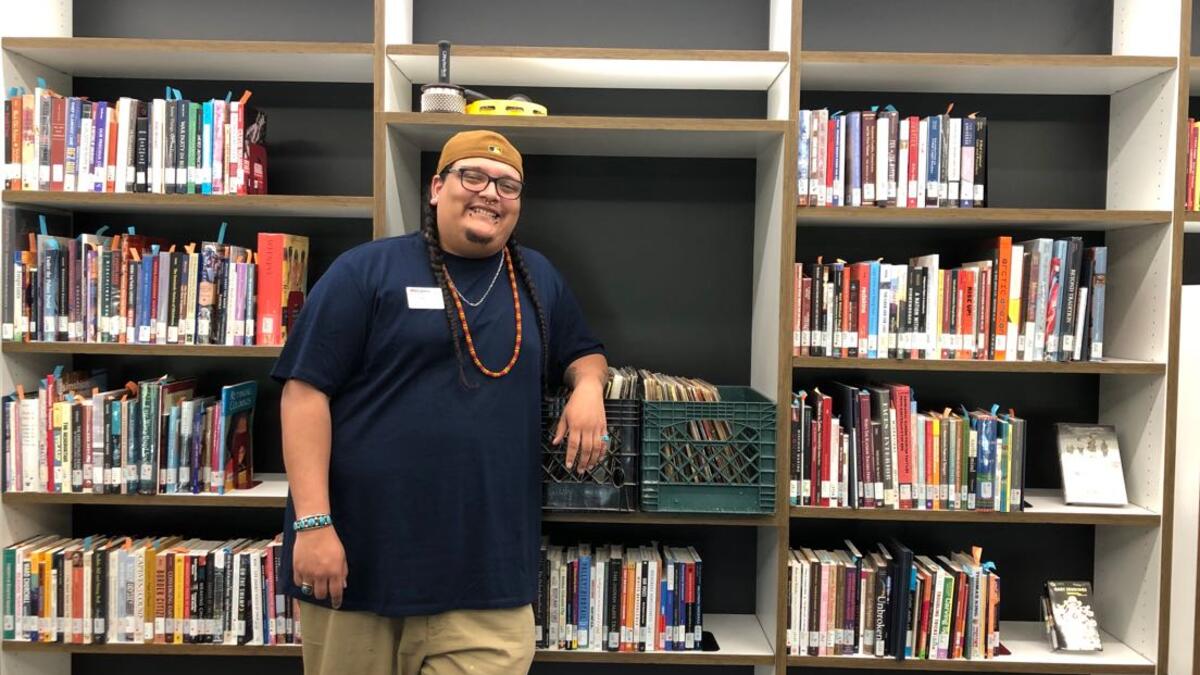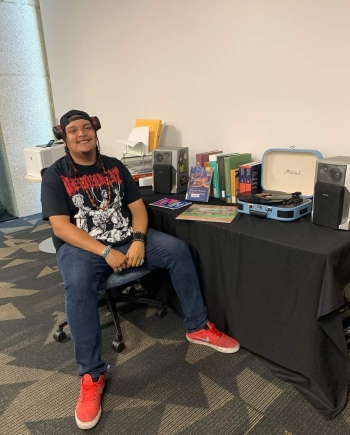ASU grad dedicated to music, libraries and Indigenous sovereignty

Nataani Hanley-Moraga (Navajo/Húŋkpapȟa Lakota/Chicano) in the Labriola Center.
Editor’s note: This story is part of a series of profiles of notable spring 2024 graduates.
If you stepped inside the Labriola National American Indian Data Center at Hayden Library in the past two years, you may have heard Nataani Hanley-Moraga before you met him. His beat making and lo-fi study sessions are just one of his many responsibilities as a student worker at the center.
Hanley-Moraga (Navajo/Húŋkpapȟa Lakota/Chicano), an enrolled member of the Navajo Nation is majoring in American Indian studies with a minor in economics and a certificate in American Indian governance from The College of Liberal Arts and Sciences. Originally from Window Rock, Arizona, Hanley-Moraga has always had a talent for music, from participating in band to writing chamber music as part of the Grand Canyon Music Festival’s Native American Composer Apprentice Program.
He started at Mesa Community College in 2017 and then transferred to Arizona State University in fall 2021. A chance encounter during that semester in front of Hayden Library changed Hanley-Moraga’s educational journey and career life. It brought him to the Labriola Center with an opportunity to revive his love of music.
“At first I thought college was not for me, but I tell other students to find their community on campus,” Hanley-Moraga said. “I found Labriola through a Sol Power event which featured Native hip-hop artists and musicians that year. I met Alex Soto, the director of the Labriola Center and he invited me to come through and share some of the beats I was making. Once I went, I knew I wanted to be here. That led to me getting a student job, creating a community and pushing me as a student and person.”
Since finding community at the Labriola Center and declaring his major in American Indian studies, Hanley-Moraga has thrived at ASU, flourishing as a student scholar, musician and “producer-in-residence” at the Labriola Center creating music for the center’s social media and lo-fi events. He interviews elders as part of the “Firekeepers” project funded by the Andrew W. Mellon Foundation, and in 2022 he won the Mr. Indigenous pageant, a student organization created to “promote the ideals of the Native American community, nationwide, with dignity, grace and friendship.”
That opportunity led to public appearances for land acknowledgments, opening blessings and presentations to K–12 students around the state sharing his school journey.
"Hearing from students that they don't see a lot of Native kids that look like me has allowed me to see myself as a role model and inspire them to go to school," Hanley-Moraga said. "Plus, I have an instant connection with kids who also love death metal."
Note: Answers have been edited for length and clarity.
Question: What was your “aha” moment when you realized you wanted to study the field you majored in?
Answer: Right around the time I was hired at the Labriola Center, I originally was majoring in economics and minoring in American Indian studies. I struggled on a physical, mental and spiritual level, and it was hard to connect with fellow students and the goals of the program.
After conversations with Alex and Eric Hardy, Eric encouraged me to explore the AIS program at ASU and see how it could bridge the gap between AIS (American Indian studies) and how it applies in the real world outside of school. It gave me a new perspective on the program and how interdisciplinary it is connecting anthropology, history, law, health care, etc. It’s interesting to see how we can use the AIS framework can help us innovate to address issues with our people.
I realized this is something I want to focus on, applying the economics framework to an AIS paradigm, bringing AIS into other fields. (Teaching Professor) Michelle Hale and (Professor Emeritus) Myla Vicenti Carpio inspired me to see connections between areas I never thought of before and to explore what an Indigenous framework looks like that could lead to new ways of thinking and research.
Q: What’s something you learned while at ASU — in the classroom or otherwise — that surprised you or changed your perspective?
A: The whole AIS concept changed my perspective. No matter what field you’re in, everything is intertwined. Applying an Indigenous framework is important to how we change these systems. In addition, higher education academic institutions can be challenging for Native students. Seeing how Alex bridges his background and the ways you can pull different areas of your life together has been a valuable learning experience. I learned how to connect my past experiences growing up, from music and other areas of my life to help me succeed in school. Knowing I have a utility belt of skills and resources from my background being able to use all of these areas to apply them to my work in a professional setting.
Q: What was your favorite spot on campus, whether for studying, meeting friends or just thinking about life?
A: The Labriola Center 100%. You feel comfortable here. It’s a place to make jokes that no one outside of our community would get, to connect with other Native students. Labriola gives you the things that you need at the time you need them. It gave me everything I needed when I needed it. Whether you need study space, quiet space, a place to take an interview, chill out, make jokes, get a snack, or even when you need traditional guidance and mentorship, Labriola has something for you.
Q: What are your plans after graduation?
A: First, sleep! Over the summer, I’ll be working on an internship with Professor Tracy Perkins doing archival work with the Fort Mohave tribe as well as attending and performing music at the national American Library Association Conference in June. In the fall I'll enter the Master of Arts in Library and Information Science at the University of Arizona in the Knowledge River Scholars Program. After I get through my program, I’m going to apply to law school. Law school has always been my main goal. I want to specialize in intellectual property and Indian Law and then eventually work in other Indigenous communities before returning to the Navajo Nation.
Q: If someone gave you $40 million to solve one problem on our planet, what would you tackle?
A: If someone gave me $40 million, I would use it to support Indigenous sovereignty, whether that is data sovereignty or government sovereignty, but giving back to the community in a tactful and strategic way. Perhaps that looks like starting an organization or grant for organizations doing innovative work based on the American Indian studies paradigm.
We need people to do the groundwork and money spend strategically to do the work. Labriola started like that with an endowment, with people and support now and contributions, and giving it all back to the community and students, its impact is years in the making.
Written with contributions from Elena Bras, ASU Media Relations.
More Sun Devil community

Supporters show their generosity during Sun Devil Giving Day 2025
Thousands of Arizona State University supporters from across the globe came together on Sun Devil Giving Day on March 20 to give to scholarships, research, student programs and university initiatives…

New ASU women's basketball coach has sights set on championships
Molly Miller apologized for being a few minutes late for her Zoom interview Sunday afternoon.No apology was necessary.It’s been a crazy and hectic 72 hours for Miller, who guided Grand Canyon…
SolarSPELL wins 'best in show' award at South by Southwest
Arizona State University professors from a variety of disciplines made a big splash at the South by Southwest festival of technology and culture in Texas earlier this month.The ASU SolarSPELL…


